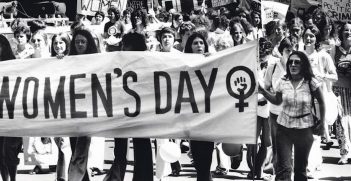It’s About Violence, Not the Patriarchy: How Feminism is Failing Women

Among the many sad things you see working in violence prevention, one of the saddest is just how useless many violence prevention efforts really are. This is especially apparent in the domestic and gender-based violence spaces, where for all the sound and fury, a myriad of well-intentioned programs wind up signifying nothing.
This is not only an Australian problem, but something the majority of Western nations have in common. Millions of dollars are spent on awareness campaigns about “stopping violence” and “respecting women.” School curricula embrace programs that “challenge gender stereotyping and negative attitudes.” University students tick boxes to show they understand the meaning of an “enthusiastic yes” before they can enrol. Workforces sit through training about how not “calling out” comments that somebody, somewhere, might find offensive, contributes to the brutal abuse of women. Other than the warm fuzzy feelings they produce, these programs have few tangible benefits.
On the infrequent occasions when these feel-good efforts are seriously evaluated rather than simply accepted at face value, the findings are characteristically underwhelming. While participants may say they have learned new things or report short-term changes in attitudes, persistent results are seldom apparent, and real-world behavioural outcomes scarcer still. The funds, time, and energy poured into these programs bears little relationship to what the data and other evidence tells us about violence against women.
Alarmingly, when it comes to trying to change the behaviour of men who are actually violent towards women, a consistent finding is that intervention programs for offenders frequently have little – if any – impact on reoffending. When you compare recidivism statistics for offenders who have been through “behavioural change” programs with offenders who have not, it is hard to tell them apart.
The other common factor that most programs share – whether they are aimed at the general public, schoolchildren, or offenders – is that they are based almost exclusively on feminist principles. Prominent among these are the beliefs that males occupy a privileged place in society and that the patriarchy subordinates women in order to maintain its own power.
This practice model started in the early 1980s, when a radical new approach to addressing domestic violence perpetration was trialled in Duluth, Minnesota. The “Duluth Model” conceptualised domestic violence as stemming from misogynistic structures of power and control within relationships, which in turn arose from patriarchal systems of inequality in society. The model subsequently spread across the US and then to more than 20 other countries.
Duluth-style interventions focus on attitudes and behaviours built on “male privilege,” and typically include key feminist concepts and phrases about patriarchal structures and gender inequality. The theory runs that educating men about these structures and issues such as male privilege and entitlement will facilitate attitudinal and behavioural change.
Large-scale research reviews provide limited support for the effectiveness of this approach, and some studies even suggest that it may have a small negative effect. Yet, feminist theory and practice continue to dictate the focus and direction of not just batterer interventions, but the majority of other programs. Not only has this demonstrably flawed approach remained dominant, but its conceptual underpinnings have given rise to an ever-expanding scope of attitudes and behaviours that are prissily labelled “problematic.”
Laudable efforts to see domestic violence brought out from behind closed doors and recognised and punished for the crime that it is have been pushed aside by claims that not applying quotas to prestigious political or senior management roles seriously contributes to sustaining horrific psychological, financial, and physical abuse. Hard campaigning to stop victim-blaming of those who have been seriously assaulted, particularly in cases of sexual assault, has morphed into po-faced insistence that “inappropriate staring” and “unwanted compliments” are sexual violations. Fighting for victims of abuse to be heard and have their claims taken seriously has transformed into outright rejection of hard-won, fundamental legal principles – such as assuming innocence until proven guilty.
Under the banner of smashing the patriarchy, feminism sees affronting displays of male privilege wherever it looks. The powerful arguments, fierce intelligence, and sheer toughness of the first waves of feminism have been replaced with meaningless slogans, cries of “misogyny” at the faintest hint of criticism, and a list of grievances that grow pettier by the day. Naturally, with each new “problematic behaviour” come demands for action. This has reached such proportions that, internationally, it sustains entire branches of government, along with numerous research centres who churn out safely mediocre studies designed to keep themselves in work.
Against this backdrop thrives a massive industry of largely female consultants and other hangers-on who make a lucrative career out of perpetuating convenient dogma. Add to that a legion of niche human resources and related positions, which again are chiefly held by women, and it looks increasingly as if all the attention and activity serve as little more than a vehicle through which predominantly middle class, well-educated women advance their careers under the righteous guise of changing the world.
Meanwhile, in our apparently enlightened Western society, domestic violence statistics remain stubbornly resistant to change. Feminism is failing the abused women it once cared so much about.
While the feminist response to this problem is that more feminism is the answer, a more objective view is that maybe – just maybe – it is time to take a different approach. The evidence speaks very clearly to us about connections between domestic violence and alcohol and other drug misuse, poverty and social disadvantage, and intergenerational experiences of abuse. It is no coincidence that the most promising approaches to addressing domestic violence, and especially reoffending, make these issues their focus.
All ideologies have their day, and sprinkling a healthy dose of atheism on the religion of feminism is long overdue.
Lillian Andrews holds a Bachelor of Laws and has spent the past 15 years as a researcher, advocate, and volunteer in the field of domestic violence prevention.
This article is published under a Creative Commons Licence and may be republished with attribution.





